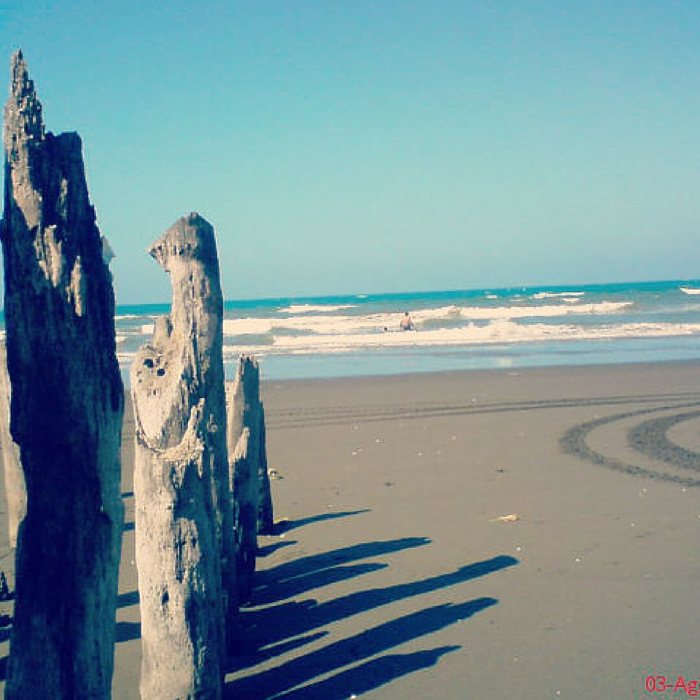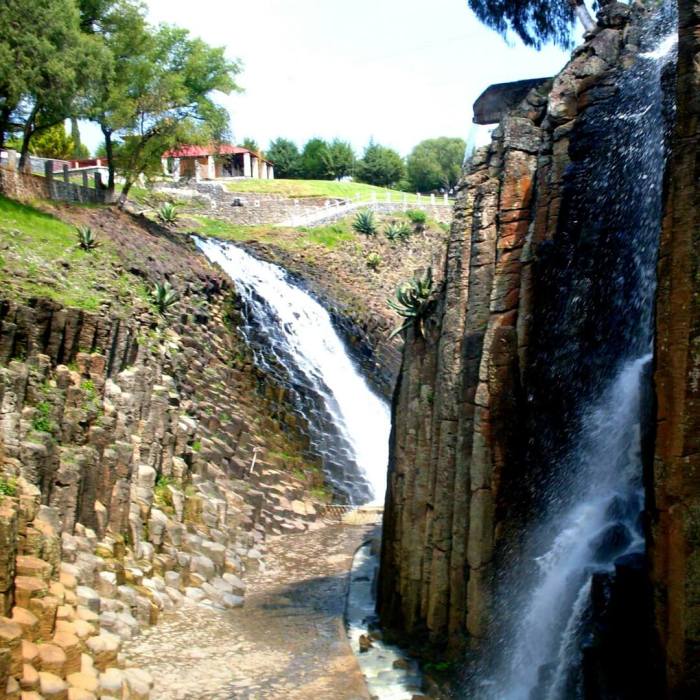Hola, amigos! I’m often asked about how safe it is to visit Mexico. There are so many horror stories on the news, I’m sure many people think visiting Mexico is like jumping into the zombie apocalypse. That is not true at all, but you do have to follow certain guidelines to stay safe when traveling to Mexico.
Click to tweet this post
Click on the left to subscribe!

One of the biggest myths about Mexico is that the whole country is a violent death trap. I admit it’s true that many gruesome things are going on, but I also advice you to put things into perspective.
Mexico is one of the largest countries in the world. That means that a dangerous situation does not necessarily affect the entire country. There are also many places in Mexico where everything is perfectly safe, calm, and peaceful.

Visiting Mexico is like visiting any other country. There are places you should visit and places you should avoid. There are things you can do and things you shouldn’t do.
However, you should play it safe. At the risk of angering the Mexican ministry of Tourism and many of my countrymen, I will be completely honest and share with you a few tips to help you stay safe in Mexico.
10 Guaranteed Ways To Stay Safe In Mexico
1. Don’t go to these dangerous places
You’ve heard on the news that there are violent and dangerous places in Mexico, and I’m sorry to say that this is very true. Fortunately, you don’t need to go to any of those places because all the tourist attractions and resorts are somewhere else.
This map shows you the states you should avoid (in yellow), according to the U.S. State Department. As you can see, most of the country is safe to visit.

In general, avoid the states that border with the USA, including Sonora, Baja California Norte, and also the state of Sinaloa.
Unfortunately, these states are part of trafficking routes and that’s what makes them so dangerous. Yes, there are things to see there, but it’s better not to risk it.
You also shouldn’t go to the states of Guerrero and Michoacan. Although they are not in this travel advisory section, they have recently been rocked by cartel violence and you should stay away from them.
2. Visit these safe and wonderful places
Most of the states in green (except for Sinaloa, Baja California Norte, Michoacan, and Guerrero), and all of the states in blue are perfectly safe to visit.
All of the most popular tourist attractions are in one of these safe zones. Los Cabos and Todos Santos are in Baja California Sur; Cancun, Cozumel, Playa del Carmen, Tulum, and the Maya Riviera are in Quintana Roo; and Puerto Vallarta is in Jalisco.
There are other very attractive and very safe places to visit in Mexico that are not beach resorts: Oaxaca, San Cristobal de las Casas, Merida, Puebla, Guadalajara, Guanajuato, Queretaro, and Mexico City are all beautiful and interesting to see.

Better yet, these cities also offer other awesome little places only a short ride away. Mexico City has the pyramids of Teotihuacan nearby; the ancient ruins of Monte Alban are close to Oaxaca; from the white city of Merida you can catch a tour to the awesome Chichen Itza; the charming town of San Miguel is close to the city of Guanajuato; the picturesque Peña de Bernal is near Queretaro; and beautiful Cholula is right next to Puebla.
Also on the safe and wonderful side are the states of Hidalgo and Tlaxcala. The attraction there is to visit old towns and haciendas to get a taste of life in old Mexico.
Other places you can’t miss are the beach town of Huatulco in Oaxaca, the tropical city of Villahermosa and the Mayan ruins of Palenque in Tabasco, and Mexico’s rainforest version of the Grand Canyon, El Cañon del Sumidero in Chiapas.

It’s worth noting that I did not mention even half of all the amazing places you can visit safely in Mexico. Sorry about that, but I couldn’t ever finish this post if I tried!
3. Be careful when you visit these other places
There are other famous places in Mexico that are worth a visit, but with certain precautions.
In Guerrero, you can visit the beach resorts of Acapulco, Ixtapa, and Zihuatanejo, as well as the colonial city of Taxco. In Michoacan, the city of Morelia is so gorgeous, even the Pope didn’t miss it. And in Sinaloa, the beach town of Mazatlan is popular with cruise ships and expats.
Even though these places are inside the forbidden zones, you can go there and be safe as long as you don’t wander away from the tourist areas. Also, it’s better to fly there instead of taking a bus or driving.
4. Travel safely
If you want to travel within Mexico, it’s best to fly, sign up for a tour, or take a first-class bus. Driving around is not a good idea.
I honestly don’t recommend that you rent a car. First of all, roads can be extremely confusing, and you might get hopelessly lost. Also, secondary highways are not safe. You would be better off taking a toll highway, although those are expensive. Finally, Mexican drivers are a bit reckless, so you don’t want to join them on the road. Trust me.
If you insist on driving, make sure you do so only during daylight. Also, try to travel with a local friend who knows his way around since it’s best not to stop and ask for directions.

5. Be safe in the city
The Mexican cities I mentioned above are all perfectly safe. Of course, you should observe certain safety guidelines. There might be pickpockets and thieves in crowded places, so don’t flash your cash in public. Use ATMs only in well-lit malls and stores, and don’t walk through dark, empty streets late at night. Also, don’t get so drunk that you are not aware of what you’re doing. Hailing cabs is not a good idea either. It’s best to call a cab service.
As you can see, this is all very common sense. I feel silly even giving you these obvious tips. Then again, you never know. Right?
6. Meeting new people
Most Mexicans are extremely friendly and courteous with foreigners. You’ll probably find that everyone is willing to lend you a helping hand if you need it.
You should know that English is NOT spoken everywhere, so most of the time you’ll have to get by with whatever bits of Spanish you know. But don’t worry! Even if your Spanish is awful, Mexicans will try their best to figure out what you’re saying.
As always, use your common sense when socializing. Accepting drinks and rides from complete strangers is never a good idea no matter where you are.

7. On blending in or standing out
Some sites recommend that you try to blend in as much as possible and avoid calling unnecessary attention to yourself. I have to say that’s much easier said than done. Everyone here can spot a foreigner from a mile away, so blending in is not really an option.
However, I do agree that you shouldn’t flash jewelry, cash, or expensive gadgets. That’s just an invitation to get robbed.
To be honest, Mexico is not the only place where you can get robbed. One of my friends got his camera stolen right out of his hands when he was walking through Paris, so this sort of thing can happen anywhere.
8. Exploring the countryside
Mexico has amazing views and many diverse landscapes, so it’s tempting to go on a hiking adventure. You can do that, and it’s perfectly safe as long as you follow basic hiking safety guidelines, such as not going out by yourself.
I do have to warn you against driving on rural roads. You might get lost and cell phone coverage in those areas is non-existent. It’s better to make sure that the hiking tour includes transportation to and from the hotel.

9. Getting crazy
Lots of people think of Mexico as an ideal place to get crazy, specially during spring break. As you can imagine, this goes against all the common sense safety rules I just mentioned.
Local authorities work hard to take good care of tourists so they can have a good time, but that doesn’t mean you should take part in risky situations. Getting into a drunken fight at a seedy joint is never a good idea, for example.
Also, adult entertainment spots are popular with members of the organized criminal gangs and cartel people, so it’s dangerous to go there. Just don’t do it, people.
10. Kidnapping, carjacking and other nightmares
As a tourist, your risk of getting kidnapped in Mexico is practically zero. Sadly, kidnapping for ransom is a real danger for ordinary Mexicans citizens, but not for tourists. Just use your common sense, avoid risky situations, and use ATMs only in stores and malls.
Carjacking is also a problem on Mexican highways, but that mostly happens to people who drive around late at night on lonely roads. It’s also a matter of common sense not to do that, so carjacking shouldn’t be a problem at all.
Finally, there are the random stories of people disappearing and getting butchered somewhere in Mexico. Quite frankly, that will only happen if you insist on wandering around places you’re not supposed to be, such as dangerous states (see map above), seedy joints, dark alleys, and back roads.

10 Guaranteed Ways To Stay Safe In Mexico
- Don’t visit places where travel is not advised (see map above).
- Go to places where travel is deemed safe (see map above).
- If there is a travel advisory, stay in tourist areas.
- Avoid driving around by yourself. It’s best to fly or take a bus.
- Travel by road only during daylight, and avoid secondary and rural roads.
- Use ATMs only in well-lit stores and malls.
- Don’t flash cash, jewelry or expensive gadgets.
- Don’t wander around seedy spots and joints.
- Don’t accept drinks and rides from complete strangers.
- Don’t get excessively drunk and crazy.

The Bottom Line
Visiting Mexico is quite safe if you follow basic, common sense safety rules like the ones I mentioned above. As a matter of fact, you should follow those common sense safety rules no matter what country you’re visiting.
However, it’s sad for me to admit that there are dangerous places in Mexico that you should never set foot on. Honestly, that is a shame. The entire country should be safe and open for all its citizens and tourists.
It’s true several horrible incidents involving tourists have happened- Adam Coleman and Dean Lucas, Harry Devert and Craig Taylor were all tourists who ended up dead. Actually, they were doing exactly the things I just advised you should never do. Nevertheless, I do not blame them. I believe people should be able to come to Mexico and not be in danger at all. Ever.
The bottom line is, if you want to come to Mexico, don’t be afraid to do so. I just shared some very simple, easy ways that guarantee you’ll stay safe and have fun.
My best piece of advice is to come to Mexico and have the best time of your life. Visit a few of the many amazing places I mentioned, have some good food, and enjoy your time here. I promise you’ll want to return, or perhaps you’ll never want to leave!









